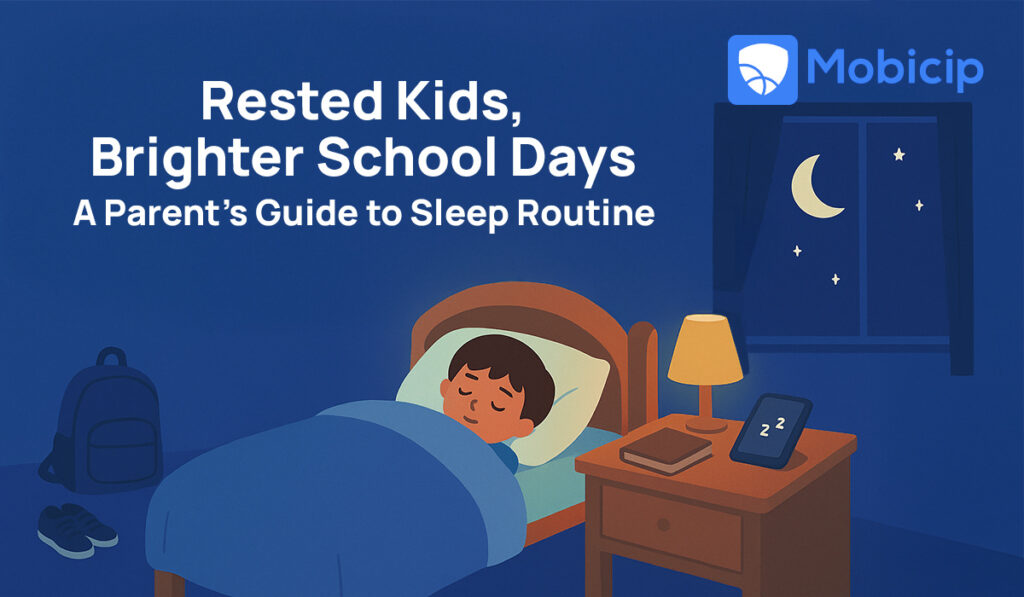How To Set Up Kids For Success during Back-to-School Season?

So, teach us something worth knowing,
Bring us back what we’ve forgot,
Just do your best, we’ll do the rest,
And learn until our brains all rot.
– The School Song of Hogwarts, J. K. Rowling.
As the iconic lyrics from Hogwarts’ School Song remind us, education is an ever-evolving journey of discovery, growth, and, let’s face it, a bit of magical chaos caused by well-meaning elves. As summer wanes, back-to-school season sweeps across the U.S., spanning from late July to after Labor Day. In Southern states, students often return in early August, a practice rooted in the late 1800s when urban schools sought to address declining attendance during summer months. While this time can spark excitement for a new school year, it also brings stress for parents tasked with preparing their children, from selecting backpacks to stocking up on supplies.
However, with the right preparation, the back-to-school period can be transformed into an opportunity for our children to learn and enjoy. So, let’s wave our wands (or maybe just our planners) and see how we can make this school year the best one yet for our wards.

1. Establishing a Routine
A consistent school routine is the ultimate spell that keeps the household running smoothly. When our kids know what’s coming next, they can better focus on the task at hand rather than worrying about what’s around the corner. Our responsibility as parents is to help our children have a routine on school days that can make it less stressful for them and us.
A good morning routine that includes a regular wake-up time, a healthy breakfast, and time for preparing backpacks and reviewing the day’s schedule can work like a charm. This routine not only helps children stay on track with school deadlines but also keeps us, parents and caregivers, informed about their children’s academic activities. Evening routines are also essential to help children complete their homework, relax, and get ready for the next day’s school.
While a routine is essential for establishing a successful school year, it doesn’t have to be dull—nobody wants to feel trapped in a joyless cycle of endless Mondays. Be sure to carve out time so children can burn off energy, enjoy some fresh air, and socialize before transitioning into the evening homework routine. If your child resists the routine, try to involve them in the planning process. This can give them a sense of control and make them more likely to adhere to the routine.
A bedtime routine is essential, especially for younger children, for healthy sleep habits so that they can start the next day with energy and enthusiasm. Start with dinner as a family, followed by a bit of downtime, such as reading or a simple board game. Establish a regular bedtime with a relaxing ritual like a warm bath or listening to a favorite audiobook.

2. Creating a Productive Study Environment
We, as parents, have the power to design a healthy and safe study environment for our children, fostering a productive learning atmosphere. Assign an area of your home that is comfortable, well-lit, and stocked with necessary school supplies like pens, paper, and reference materials. Whether it’s a cozy corner of a room or a dedicated desk, having a consistent spot for studying signals to our children that it’s time to focus on their work.
To maximize productivity, we must ensure the study area is free from distractions. Helping our children keep the space tidy and organized can help—after all, a clean cauldron produces the best portion. If possible, we could limit background noise and consider using noise-canceling headphones. Additionally, we need to set clear boundaries about when and how long devices can be used in the study space, which can help maintain focus.

This is where tools like Mobicip can help. With its screen time management features, Mobicip allows parents to set limits on device usage and block distracting apps or websites during study hours. By fostering a distraction-free environment and leveraging technology to help manage screen time, you can support your child in developing effective study habits and enhance their ability to concentrate on their learning, turning their study time into a magical experience.

3. Healthy Sleep Habits
Adequate sleep is not just important; it’s vital for academic success. It directly impacts memory, concentration, and overall cognitive function. As parents and caregivers, it’s our responsibility to create a consistent bedtime routine that signals it’s time to wind down. This can include calming activities such as reading a book, practicing mindfulness, enjoying a warm bath, and setting the stage for a restful night. It is best to avoid screen light during wind-down time.
As the school year approaches, slowly adjust your child’s wake-up time to align with their school schedule. Start by shifting bedtime and wake-up times by 15 to 30 minutes each day leading up to the school reopening date, allowing their bodies to acclimate without feeling groggy. By prioritizing healthy sleep habits, you can help your child harness their full potential and approach each day with the energy and focus of a true magical scholar.
4. Nutrition and Meal Planning for Kids
Nutrition is crucial in fueling a child’s energy and concentration and boosting performance. Although food is the first of the five Principal Exceptions to Gamp’s Law of Elemental Transfiguration and cannot be produced from thin air even in the wizarding world, it is certainly possible to make interesting and healthy food items for children that spark their curiosity and delight their taste buds. Healthy meals provide the essential nutrients needed for cognitive function, helping children stay alert and engaged throughout the school day. To ensure good nutrition for kids:
- Focus on planning nutritious breakfasts, lunches, and snacks that are balanced and appealing.
- Start the day with whole grains, fruits, and protein—think oatmeal topped with berries or scrambled eggs with vegetables.
- For lunch, opt for lean proteins, whole grains, and colorful veggies, such as a turkey wrap with spinach and carrots.
Involving kids in meal preparation can make eating healthy more exciting and fun. Allow them to choose recipes, help with grocery shopping, or assist in cooking. This will foster ownership and encourage them to try new foods.
5. Encouraging Physical Activity
Regular physical activity is important for children’s overall health and well-being, offering benefits that extend beyond physical fitness. Exercise helps improve concentration, boosts mood, and enhances academic performance. To incorporate exercise into daily routines, look for opportunities that fit seamlessly into family life. This could include walking or biking to school, playing tag in the backyard, or organizing weekend outings to local parks or sports facilities. Whether it’s a quick basketball game, a few laps in the pool, rollerblading down the sidewalk, or even a friendly Quidditch match (broomsticks optional), these activities can make exercise enjoyable.
Balancing screen time with physical activity is extremely important in today’s digital age. Encourage children to take active breaks during homework sessions, such as doing jumping jacks or a quick dance party, to recharge their energy. By making physical activity a fun and regular part of their lives, you can help children develop lifelong habits that support their well-being.

6. Promoting a Growth Mindset
A growth mindset is about believing that effort and perseverance can improve skills and intelligence. As Dumbledore said, “It matters not what someone is born, but what they grow to be.” This way of thinking helps kids see challenges as chances to learn, understand that failures are just part of the process, and keep going even when things get tough. To foster this mindset:
- Engage children in discussions about the importance of effort and resilience, emphasizing that even the greatest wizards face difficulties.
- Incorporate activities that promote problem-solving, such as puzzles or group projects, where mistakes are seen as valuable learning experiences.
- Provide resources like books and videos that highlight growth mindset principles.
7. Managing Stress and Anxiety
It’s important to recognize the signs of stress and anxiety in children, particularly as they transition back to school. Stress indicators include irritability, changes in sleep patterns, or reluctance to engage in activities. Make it easier for children to talk openly about feelings and stress. Start by encouraging honest conversations and letting children know their experiences are valid and important. This approach not only helps in managing stress but also builds trust and understanding.
You can also introduce simple relaxation techniques like deep breathing or mindfulness exercises. These small steps help build emotional strength and make handling stress easier. Stress may often result from overindulgence in digital spaces and tools or problems in interpersonal relationships online. Mobicip can enable online safety for kids by allowing parents to monitor digital interactions and limit exposure to stressful content.
8. Staying Organized
Staying organized is important for academic success and helps children manage their assignments, activities, and deadlines effectively. Encourage kids to use planners or digital calendars to jot down due dates, upcoming tests, and extracurricular activities. Setting aside a specific time each week to review and update their schedules can help instill a sense of responsibility. Visual aids can also be beneficial, such as color-coded physical folders for different subjects or a whiteboard for tracking tasks.
Teach children to prioritize their tasks, breaking larger projects into manageable steps. Effective organization can help children develop logical thinking skills, enabling them to “look past extraneous detail and perceive clearly that which others overlook,” as Hermione Granger would undoubtedly agree.
9. Communicating with Teachers and School Staff
Building strong relationships with teachers is crucial for fostering a supportive educational environment. Open communication helps parents stay informed about their child’s progress and any challenges they may face. For effective communication, reach out to teachers with questions or concerns using email or phone calls.
Attending parent-teacher meetings is an excellent opportunity to discuss your child’s progress and areas for improvement. Staying engaged with school staff and participating in school events also helps parents understand the school culture and community.
Take Away
As we embark on this school year, let us remember that each child is a wizard in their own right, ready to discover their unique talents and abilities. Embrace the inevitable chaos and celebrate the small victories along the way. Foster an environment where curiosity flourishes, and resilience is nurtured, turning challenges into stepping stones. So, as we navigate the ups and downs of school life, let’s ensure that every child feels valued and empowered, for it is in this supportive atmosphere that they will truly thrive.
FAQs
How can I help my child adjust to a new school routine?
Start by gradually introducing the school schedule a week or two before classes begin. Start shifting bedtime and wake-up times to match the school schedule, and try setting up consistent morning and evening routines. This way, the transition back to school feels smoother and less stressful. Make it fun by incorporating enjoyable activities, such as a family breakfast or a relaxing wind-down ritual. Encourage your child to voice any concerns and be patient as they adapt to the changes.
What are some healthy breakfast ideas for school mornings?
Opt for quick and nutritious options like whole-grain toast with avocado, overnight oats topped with fruit, or smoothies packed with spinach, banana, and yogurt. Breakfast burritos with scrambled eggs and veggies are also great for busy mornings. Involving your child in choosing and preparing breakfast can make it more appealing and encourage healthier eating habits.
How can I manage my child’s screen time effectively?
Set clear guidelines for screen time by establishing specific hours for recreational and family activities. Use tools like Mobicip to monitor and manage screen usage, allowing you to block distracting apps during study hours. Encourage breaks from screens by scheduling outdoor activities, family game nights, or creative projects that engage your child’s imagination.
What should I do if my child is anxious about going back to school?
Listen to your child’s concerns and validate their feelings without dismissing them. Encourage open communication about what specifically makes them anxious and provide reassurance. Together, practice relaxation techniques, such as deep breathing or mindfulness exercises. Familiarize them with their new environment by visiting the school before classes start. If anxiety persists, consider consulting a school counselor or child psychologist for additional support.





